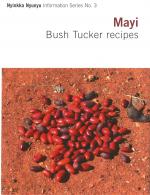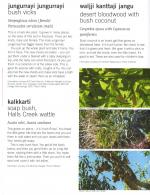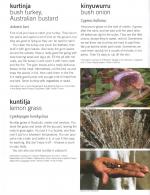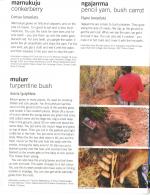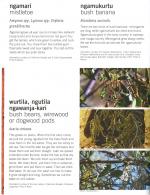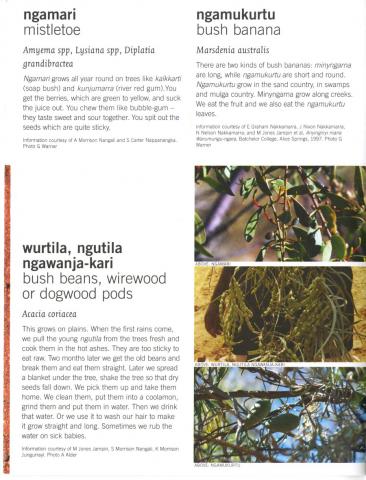Mayi: Bush Tucker Recipes (page 7)
ngamari (mistletoe; Amyema spp, Lysiana spp, Diplatia grandibractea)
Ngamari grows all year round on trees like kalkkarti (soap brush) and kunjumarra (river red gum). You get the berries, which are green to yellow, and suck the juice out. You chew them like bubble-gum - they taste sweet and sour together. You spit out the seeds which are quite sticky.
A Morrison Nangali and S Carter Nappanangka. Photo G Warner
wurtila, ngutila, ngawanja-kari (bush beans, wirewood or dogwood pods; Acacia coriacea)
This grows on plains. When the first rains come, we pull the young ngutila from the trees fresh and cook them in the hot ashes. They are too sticky to eat raw. Two months later we get old beans and break them and eat them straight. Later we spread a blanket under the tree, shake the tree so that dry seeds fall down. We pick them up and take them home. We clean them, put them into a coolamon, grind them and put them in water. Then we drink that water. Or we use it to wash our hair to make it grow straight and long. Sometimes we rub the water on sick babies.
M. Jones Jampin, S. Morrison Nangali, K. Morrison Jungurrayi. Photo A. Alder
ngamukurtu (bush banana; marsdenia australias)
There are two kinds of bush bananas: minyngarna are long while ngamukurtu are short and round. Ngamukurtu grow in the sand country, in swamps and mulga country. Minyngarna grow along creeks. We eat the fruit and we also eat the ngamukurtu leaves.
E. Graham Nakkamarra, J. Nixon Nakkamarra, N. Nelson Nakkamarra and M. Jones Jampin et al., Anyinginyi marla Warumungu-ngara, Batchelor College 1997
